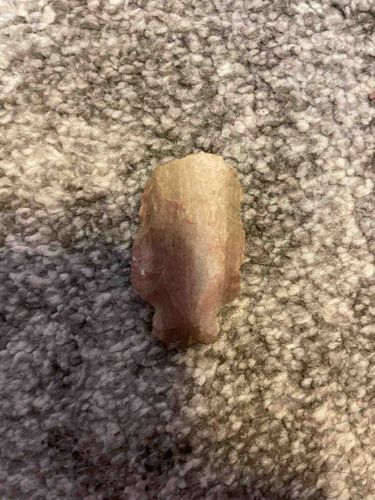
Stone Projectile Point (Arrowhead/Spearhead)
This item appears to be a stone projectile point, commonly known as an arrowhead or spearhead. It is crafted from a light-colored chert or flint, exhibiting shades of tan, beige, and faint reddish-pink hues, suggesting natural mineral inclusions or possibly heat treatment. The overall shape is lanceolate with a somewhat crude, irregular outline, indicating a likely hand-knapped manufacturing process. It features a roughly symmetrical form, though one side appears slightly straighter than the other, tapering to a blunt, possibly broken or unfinished tip. The base of the point is not clearly visible to determine if it is notched or stemmed, but it appears to be a relatively wide, straight or slightly convex base. The flaking marks are visible, characteristic of lithic reduction, though they are somewhat large and uneven, suggesting either a less refined knapping technique or significant wear/patina. The surface shows a dull, aged luster, consistent with archaeological material that has been exposed to environmental conditions. There are no discernible maker's marks or signatures. The condition appears stable, with no obvious fresh breaks or repairs visible. Based on its simplistic form and material, it likely dates to a prehistoric period, possibly Paleoindian, Archaic, or Woodland, within the context of North American indigenous cultures. The quality of craftsmanship, while functional, falls into the utilitarian category rather than exceptionally fine or artistic. The edges show some minor nicks and abrasion, which could be from use, post-depositional damage, or the manufacturing process itself. The piece is relatively thick for its apparent size, suggesting it might have been intended as a dart point or spear tip rather than a delicate arrowhead.
AI-Generated Appraisal Disclaimer
Estimated Value
$40 - $80
Basic Information
Category
Archaeological Artifact/Tool
Appraised On
December 1, 2025
Estimated Value
$40 - $80
Item Description
This item appears to be a stone projectile point, commonly known as an arrowhead or spearhead. It is crafted from a light-colored chert or flint, exhibiting shades of tan, beige, and faint reddish-pink hues, suggesting natural mineral inclusions or possibly heat treatment. The overall shape is lanceolate with a somewhat crude, irregular outline, indicating a likely hand-knapped manufacturing process. It features a roughly symmetrical form, though one side appears slightly straighter than the other, tapering to a blunt, possibly broken or unfinished tip. The base of the point is not clearly visible to determine if it is notched or stemmed, but it appears to be a relatively wide, straight or slightly convex base. The flaking marks are visible, characteristic of lithic reduction, though they are somewhat large and uneven, suggesting either a less refined knapping technique or significant wear/patina. The surface shows a dull, aged luster, consistent with archaeological material that has been exposed to environmental conditions. There are no discernible maker's marks or signatures. The condition appears stable, with no obvious fresh breaks or repairs visible. Based on its simplistic form and material, it likely dates to a prehistoric period, possibly Paleoindian, Archaic, or Woodland, within the context of North American indigenous cultures. The quality of craftsmanship, while functional, falls into the utilitarian category rather than exceptionally fine or artistic. The edges show some minor nicks and abrasion, which could be from use, post-depositional damage, or the manufacturing process itself. The piece is relatively thick for its apparent size, suggesting it might have been intended as a dart point or spear tip rather than a delicate arrowhead.
Get Your Items Appraised
Instant estimates of your treasures with AI-powered instant appraisals